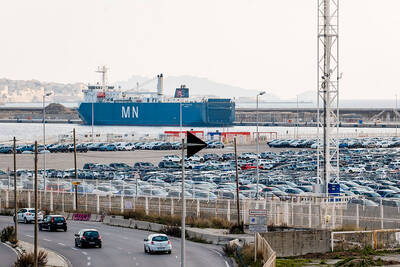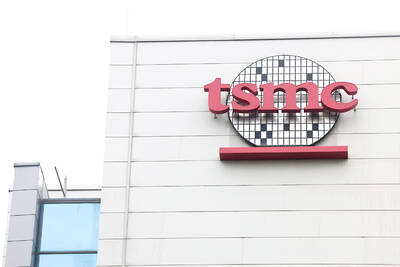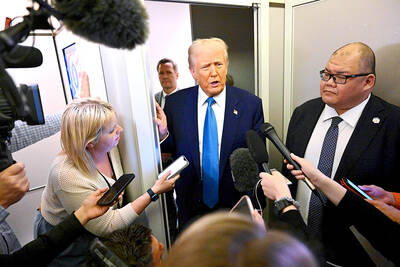The US dollar on Friday posted a second week of gains after a turbulent few days when currencies were buffeted by shifting risk appetite, with the market’s focus on next week’s US Federal Reserve meeting.
However, some analysts wondered whether the US dollar’s recent rally might be losing momentum.
The US dollar index, which measures the greenback against a basket of six major currencies, rose slightly for the day to 92.91. For the week, added 0.2 percent, after rising 0.6 percent previously.
However, that was off a three-and-a-half-month high of 93.194 hit on Wednesday, after strong Wall Street earnings helped investors regain some confidence amid earlier worries that the Delta variant of SARS-CoV-2 could derail the global recovery.
In Taipei, the New Taiwan dollar fell against the greenback, losing NT$0.010 to close at NT$28.028, little changed from last week’s NT$28.005.
Risk appetite among investors remained high on Friday, with US stocks rising, US Treasuries selling off, most commodity currencies well-bid on the day and the greenback off its peaks.
“The dollar looks tired especially after the rally of the last few weeks,” said Erik Nelson, macro strategist at Wells Fargo Securities in New York. “It seems to be running out of steam both from a fundamental and technical perspective.”
So far this month, the US dollar has gained 0.6 percent, after rising 2.8 percent last month.
However, Nelson was not convinced that the dollar could hold its gains in the coming weeks given the decline in US Treasury yields.
Since the beginning of this month, US benchmark 10-year Treasury yields have lost 16 basis points, on track for their largest monthly fall since March last year.
Against the safe-harbor yen, the US dollar rose 0.3 percent to ¥110.53.
The Australian dollar — viewed as a proxy for risk appetite — slid 0.1 percent to US$0.7374, posting a fourth straight weekly loss. With half the Australian population under lockdown, economists said the country’s central bank could increase stimulus rather than decrease it at its next policy meeting.
Additional reporting by CNA, with staff writer

When an apartment comes up for rent in Germany’s big cities, hundreds of prospective tenants often queue down the street to view it, but the acute shortage of affordable housing is getting scant attention ahead of today’s snap general election. “Housing is one of the main problems for people, but nobody talks about it, nobody takes it seriously,” said Andreas Ibel, president of Build Europe, an association representing housing developers. Migration and the sluggish economy top the list of voters’ concerns, but analysts say housing policy fails to break through as returns on investment take time to register, making the

‘SILVER LINING’: Although the news caused TSMC to fall on the local market, an analyst said that as tariffs are not set to go into effect until April, there is still time for negotiations US President Donald Trump on Tuesday said that he would likely impose tariffs on semiconductor, automobile and pharmaceutical imports of about 25 percent, with an announcement coming as soon as April 2 in a move that would represent a dramatic widening of the US leader’s trade war. “I probably will tell you that on April 2, but it’ll be in the neighborhood of 25 percent,” Trump told reporters at his Mar-a-Lago club when asked about his plan for auto tariffs. Asked about similar levies on pharmaceutical drugs and semiconductors, the president said that “it’ll be 25 percent and higher, and it’ll

NOT TO WORRY: Some people are concerned funds might continue moving out of the country, but the central bank said financial account outflows are not unusual in Taiwan Taiwan’s outbound investments hit a new high last year due to investments made by contract chipmaker Taiwan Semiconductor Manufacturing Co (TSMC, 台積電) and other major manufacturers to boost global expansion, the central bank said on Thursday. The net increase in outbound investments last year reached a record US$21.05 billion, while the net increase in outbound investments by Taiwanese residents reached a record US$31.98 billion, central bank data showed. Chen Fei-wen (陳斐紋), deputy director of the central bank’s Department of Economic Research, said the increase was largely due to TSMC’s efforts to expand production in the US and Japan. Investments by Vanguard International

WARNING SHOT: The US president has threatened to impose 25 percent tariffs on all imported vehicles, and similar or higher duties on pharmaceuticals and semiconductors US President Donald Trump on Wednesday suggested that a trade deal with China was “possible” — a key target in the US leader’s tariffs policy. The US in 2020 had already agreed to “a great trade deal with China” and a new deal was “possible,” Trump said. Trump said he expected Chinese President Xi Jinping (習近平) to visit the US, without giving a timeline for his trip. Trump also said that he was talking to China about TikTok, as the US seeks to broker a sale of the popular app owned by Chinese firm ByteDance Ltd (字節跳動). Trump last week said that he had